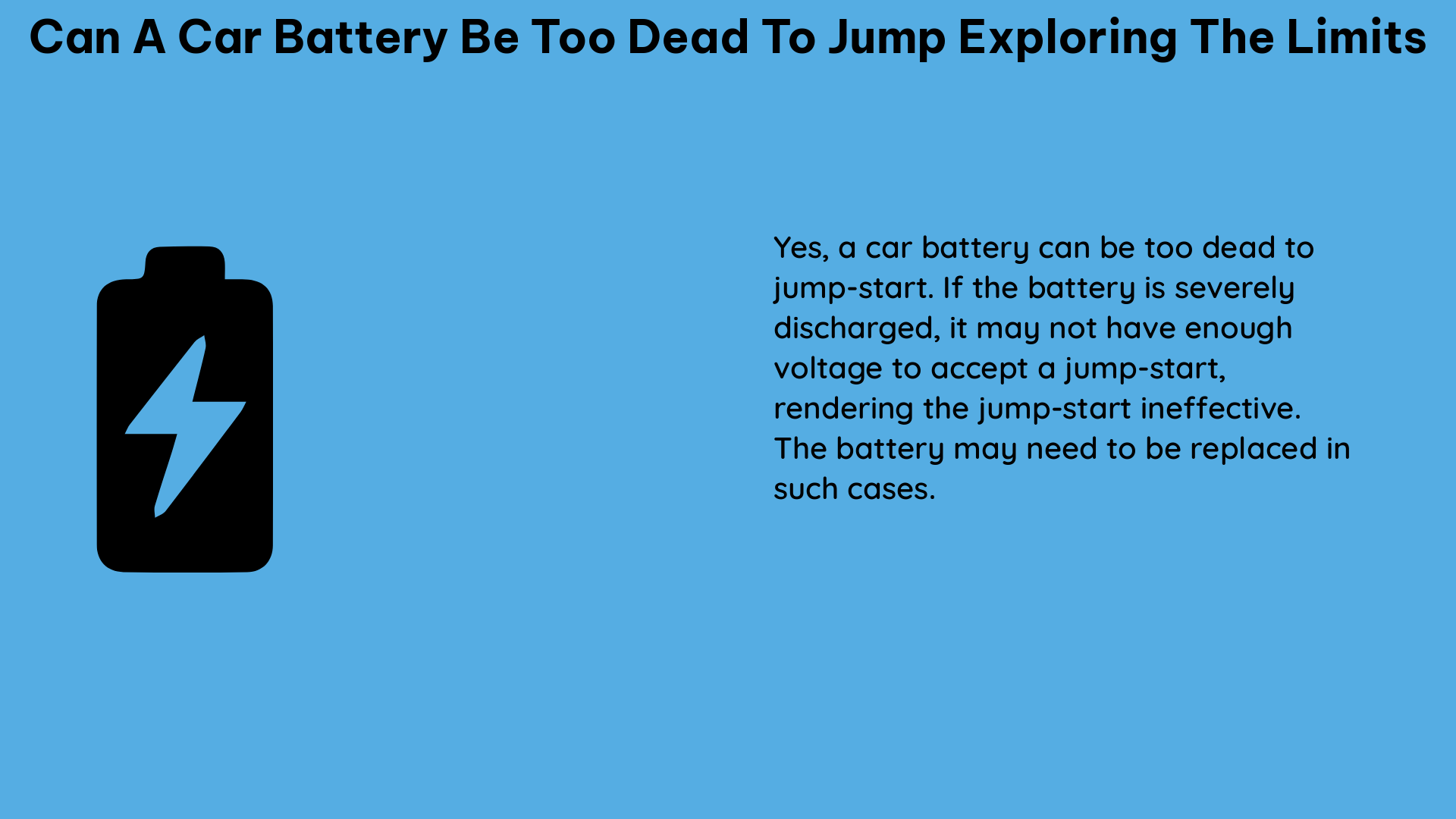Summary
Determining whether a car battery is too dead to jump-start requires understanding the technical specifications and limits of the jump-starting process. This comprehensive guide delves into the factors that can render a battery too depleted to be revived, the importance of jumper cable gauge and length, and the necessary steps to ensure a successful jump-start.
Understanding Battery Depletion Levels

When a car battery is severely discharged, it can reach a point where it becomes too dead to jump-start effectively. This can happen due to several reasons:
- Dead Cell or Internal Short: A battery with a dead cell or an internal short will drain the jumper pack before it can provide enough power to operate the starter.
- Extremely Low Charge: If the battery’s voltage drops below 8 volts, it is likely too depleted to be jump-started, as the jumper pack may not have enough power to overcome the battery’s low charge.
- Low Resistance Path: A battery with a low resistance path between the terminals can cause an arc flash and potentially start a fire when jump-starting, making the process unsafe.
Jumper Cable Specifications
The choice of jumper cables is crucial when attempting to jump-start a car. The cables must be able to deliver a sufficient amount of current to the dead battery. Here are some key specifications to consider:
- Cable Gauge: The cable gauge determines the amount of current that can be safely transmitted. A 4-gauge cable, for example, can deliver up to 220 amps at 12 volts with less than a 10% voltage drop over a distance of approximately 22 feet (6.7 meters).
- Cable Length: The length of the jumper cables is also important, as longer cables can result in greater voltage drops. Ideally, the cables should be long enough to reach between the two vehicles without straining, but not excessively long, as this can reduce the available current.
- Contact Surface Area: Ensuring a good connection between the jumper clamps and the battery terminals is crucial. The minimum viable contact surface area should be equal to the cross-sectional area of the cable to prevent excessive resistance and voltage drops.
Step-by-Step Jump-Starting Procedure
When attempting to jump-start a car with a dead battery, it’s important to follow the proper procedure to ensure safety and effectiveness. Here’s a step-by-step guide:
- Park the vehicles close enough for the jumper cables to reach, but not touching.
- Engage the parking brakes on both vehicles and turn off all electrical components (lights, radio, etc.).
- Identify the positive (+) and negative (-) terminals on the dead battery.
- Connect one end of the red jumper cable to the positive terminal of the dead battery.
- Connect the other end of the red jumper cable to the positive terminal of the good battery.
- Connect one end of the black jumper cable to the negative terminal of the good battery.
- Connect the other end of the black jumper cable to a metal ground on the dead vehicle, such as an unpainted bolt or the engine block.
- Start the engine of the vehicle with the good battery and let it run for a few minutes.
- Attempt to start the vehicle with the dead battery.
- If the vehicle does not start, let the good battery charge the dead battery for a few more minutes before trying again.
- Once the vehicle with the dead battery is running, remove the jumper cables in reverse order (black from ground, black from good battery, red from good battery, red from dead battery).
Troubleshooting Tips
If the jump-starting process is unsuccessful, there are a few troubleshooting steps you can take:
- Check the battery voltage using a multimeter. If the voltage is below 8 volts, the battery may be too depleted to jump-start.
- Inspect the battery terminals and jumper cable connections for corrosion or poor contact.
- Ensure that the jumper cables are of the appropriate gauge and length to deliver sufficient current.
- If the battery is still not responding, it may have a more serious issue, such as a dead cell or an internal short, and may need to be replaced.
Conclusion
Determining whether a car battery is too dead to jump-start requires a thorough understanding of the technical specifications and limits of the jump-starting process. By following the guidelines outlined in this guide, you can ensure a safe and effective jump-start, even for severely depleted batteries. Remember to always prioritize safety and seek professional assistance if you are unsure about the condition of your battery or the jump-starting process.
References
- Under what circumstances can a car battery be too dead to allow a jump start?
- Can a Car Battery be Too Dead to Jump?
- Does it really kill your car battery to jump someone else’s car?

The lambdageeks.com Core SME Team is a group of experienced subject matter experts from diverse scientific and technical fields including Physics, Chemistry, Technology,Electronics & Electrical Engineering, Automotive, Mechanical Engineering. Our team collaborates to create high-quality, well-researched articles on a wide range of science and technology topics for the lambdageeks.com website.
All Our Senior SME are having more than 7 Years of experience in the respective fields . They are either Working Industry Professionals or assocaited With different Universities. Refer Our Authors Page to get to know About our Core SMEs.